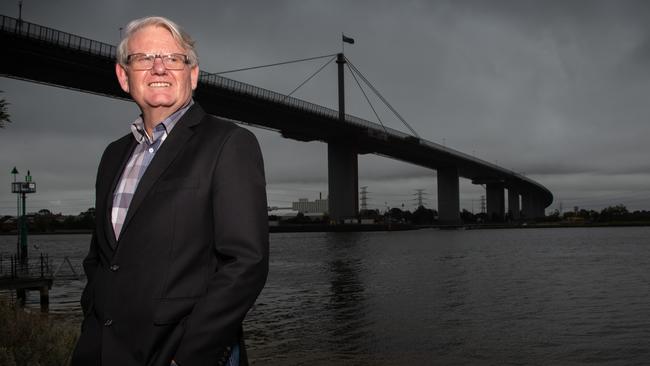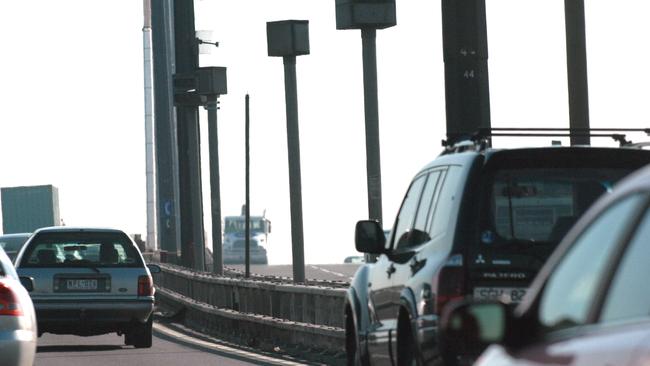Push for point-to-point speed cameras to watch West Gate Bridge
Speed cameras would be installed to cover the West Gate Bridge in a push from Victoria’s road safety camera boss. Stephen Leane said point-to-point cameras would be a massive deterrent. They’d also be installed on the Monash, Tullamarine and Eastern freeways.
News
Don't miss out on the headlines from News. Followed categories will be added to My News.
Victoria’s speed camera boss is targeting lead-footed motorists on the West Gate Bridge with a push for a mass expansion of point-to-point technology.
The Monash, Tullamarine and Eastern freeways would also get the cameras.
Mobile point-to-point units would be deployed to rural freeways like the Western and Calder during busy periods such as long weekends.
Point-to-point cameras have been credited with a 70 per cent reduction in fatalities and serious injuries on dangerous roads overseas.
New research shows more than half of Victorians support them.
Road Safety Camera Commissioner Stephen Leane, who previously served as Victoria’s top roads cop, said a major rollout of point-to-point technology would be a massive step towards Victoria’s vision of zero road deaths.
“This is the jump forward,’’ Mr Leane said.
“If you put point-to-point systems on major freeways that take a lot of traffic you will make them safer. You see overnight speeding stops.
“Let’s calm those dangerous roads.”

Mr Leane said point-to-point cameras, already installed on the Hume Freeway and Peninsula Link, would be an effective deterrent for the 200,000 motorists who used the West Gate Bridge daily.
Their deployment on Scotland’s longest freeway the A9 – previously known as the Road of Death — had reduced fatalities by a third.
Two sets of speed cameras on the West Gate Bridge were turned off more than a decade ago because vibration and wind made them unreliable.
But Mr Leane said point-to-point technology avoided such problems and cameras could be installed at 5km intervals from the start of the bridge along a 20km stretch away from the city.
Signs would warn cameras were operating and motorists given a grace period before fines were issued with the number detected speeding publicised to raise road safety awareness.
“If you know they’re there then there’s no reason why you should be surprised if you get a ticket,’’ Mr Leane said.
“You can make 20km of both the West Gate Bridge and the West Gate Freeway safer.
“It makes that entire length of road safe.”

Point-to-point technology also eliminated “camera surfing” where drivers speed between suspected camera sites.
Research completed for the commissioner, involving more than 1200 adults statewide, shows a quarter of Victorians regularly camera surf.
One in four admit to intentional speeding.
“If people get an opportunity to speed they will,’’ Mr Leane said.
“Point to point cameras reduce the incidence of camera surfing and they also have a greater impact over a much broader length of freeway or highway than a single fixed speed camera.”
The Department of Justice and Community Safety, responsible for Victoria’s speed cameras, said in a statement: “Decisions around the placement of fixed road safety cameras, including point-to-point, are determined by the Fixed Camera Site Selection Committee, which is chaired by Victoria Police and includes key road safety partners.”
“Victoria’s road safety camera program plays a critical role in changing driver behaviour, preventing road trauma and reducing the number of lives lost on our roads,’’ it said.
“We use a wide range of enforcement approaches to help keep our roads safe, including point-to-point and fixed road safety cameras – and have made a massive investment to increase mobile camera hours by 75 per cent by May 2023, as well as trialling new technology to strengthen enforcement of distracted driving and non-use of seatbelts.”
The commissioner’s research, completed between July 15 and August 3, showed 57 per cent respondents supported point-to-point cameras.
Accuracy and concern about revenue raising were the main reasons for opposing them.
Point-to-point cameras calculate a vehicle’s average speed by determining the time it takes to travel between two points.
The old camera infrastructure on the West Gate Bridge will remain despite being deactivated while the West Gate Freeway upgrade includes fixed road safety cameras for eastbound traffic entering the bridge.
The bridge also has a lane management system to reduce the speed limit depending on traffic conditions and the environment.
Victoria’s recent 17-day roads blitz unearthed 6428 speeding offences.
Eleven people died over the period.
LEAD FOOT STATE
67% Speed at least some of the time
37% Intentionally speed at least some of the time
48% Have received at least one speed camera fine
24% Camera surf, speeding then slowing for cameras
23% Believe 105-109km/h in 100km/h zone isn’t speeding
ATTITUDE TO SPEED CAMERAS
63% Slow down if know camera in area
61% Make roads safer
55% More careful if fined
51% Drivers should be alerted to camera location
47% More about making money than safety
41% Allow for suitable margin of error
35% Very/extremely accurate
33% Cameras are fair
POINT-TO-POINT CAMERAS
57% Support use
18% Oppose use
REASONS FOR OPPOSING POINT-TO-POINT CAMERAS
58% Accuracy
52% Revenue raising
28% Privacy
23% Oppose safety cameras in general
22% Cost purchasing and maintaining
1% Cause traffic hazards
SUPPORT FOR ROAD SAFETY INITIATIVES
83% Cheaper registration or licence fees if no fines in five years
81% Random drug and alcohol testing
79% More prominent signposting of speed limits
59% Fixed speed cameras on freeways or tollways
58% Increasing number of speed/red light cameras if proceeds went to road safety
56% Mobile speed cameras
26% Lowering speed limits
Source: Road Safety Camera Perceptions Report
Based on interviews with 1233 Victorian adults, July 15 – August 3 2020.
MORE NEWS
SISTER WITNESSED TWIN’S CAR CRASH TRAGEDY
